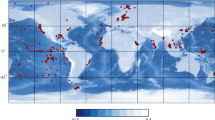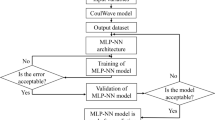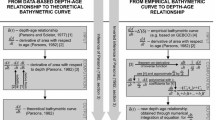Abstract
Seamount ages are important for understanding crust-mantle interactions and exploring sea bottom ore resources. Rock sampling and laboratory measurements are time-consuming and expensive, and are currently the main methods for dating seamounts. Thus, the ages of many seamounts in the Pacific Ocean are still unknown. To address this problem, gravity anomalies, magnetic anomalies, oceanic crustal ages, sediment thicknesses and seamount heights are chosen as the input parameters for seamount age prediction based on the potential relationship between geophysical observables and seamount ages. A Back-propagation (BP) neural network is constructed using the currently known seamount ages in the Pacific Ocean. Then, the weight and threshold of the BP network are optimized by a Genetic algorithm (GA); finally, the GA-BP model for seamount age production is derived. In addition, Convolutional neural network (CNN), BP model, and Support vector regression (SVR) methods are also used to predict seamount ages. The uncertainties in the prediction results decrease in the order of the GA-BP model, CNN, BP model, and SVR methods. The RMSE of the GA-BP prediction results is 10.22 Ma, and R2 is 0.90.






Similar content being viewed by others
Data availability
Gravity anomaly, magnetic anomaly, oceanic crustal age, sediment thickness and bathymetry data can be downloaded from https://topex.ucsd.edu/grav_outreach/, http://www.geomag.us/models/emag2.html, https://www.earthbyte.org/age-and-bathymetry-of-the-worlds-ocean-crust-for-the-last-140-million-years/, https://www.ngdc.noaa.gov/mgg/sedthick/ and https://www.ngdc.noaa.gov/mgg/global/global.html respectively. The geophysical observables at each seamount and the predicted age are listed in Table A1 in the Appendix.
References
Abbasion S, Rafsanjani A, Farshidianfar A, Irani N (2007) Rolling element bearings multi-fault classification based on the wavelet denoising and support vector machine. Mech Syst Signal Process 21(7):2933–2945
Amante C (2009) ETOPO1 1 Arc-Minute global relief model: procedures, data sources and analysis. https://www.ngdc.noaa.gov/mgg/global/relief/ETOPO1/docs/ETOPO1.pdf
Atanasov SS (2021) Predicting soil moisture based on the color of the leaves using data mining and machine learning techniques. IOP Conf Ser Mater Sci Eng 1031(1):012076
Bi L, Xie W, Zhao J (2019) Automatic recognition and classification of multi-channel microseismic waveform based on DCNN and SVM. Comput Geosci 123:111–120
Booker LB, Goldberg DE, Holland JH (1989) Classifier systems and genetic algorithms. Artif Intell 40(1–3):235–282
Borji M, Malekian A, Salajegheh A, Ghadimi M (2016) Multi-time-scale analysis of hydrological drought forecasting using support vector regression (SVR) and artificial neural networks (ANN). Arab J Geosci 9(19):725
Bouvrie J (2006) Notes on convolutional neural networks. Neural Nets
Cande SC, Kent DV (1992) Ultrahigh resolution marine magnetic anomaly profiles: a record of continuous paleointensity variations? J Geophys Res Solid Earth 97(B11):15075–15083
Caplan-Auerbach J, Duennebier F, Ito G (2000) Origin of intraplate volcanoes from guyot heights and oceanic paleodepth. J Geophys Res Solid Earth 105(B2):2679–2697
Carbotte SM, Dixon JM, Farrar E, Davis EE, Riddihough RP (1989) Geological and geophysical characteristics of the Tuzo Wilson Seamounts: implications for plate geometry in the vicinity of the Pacific – North America – Explorer triple junction. Can J Earth Sci 26(11):2365–2384
Chakravarthi V (1995) Modelling of density interface with binomial density variation. J Appl Geophys 34(1):69–74
Cinzia F, Hofmann A (2011) Mantle plumes. Encycl Earth Sci 44(1):111–1113
Clague DA, Dalrymple GB (2013) Cretaceous K-Ar ages of volcanic rocks from the Musicians Seamounts and the Hawaiian Ridge. Geophys Res Lett 2(7):305–308
Clouard V, Bonneville A (2005) Ages of seamounts, islands, and plateaus on the Pacific plate. Geol Soc Am Bull. https://doi.org/10.1130/0-8137-2388-4.71
Cortes C, Vapnik V (1995) Support-vector networks. Mach Learn 20(3):273–297
Daniel B, Andrew R (2018) Landscape classification with deep neural networks. Geosciences 8(7):244
Davis AS, Gunn SH, Bohrson WA, Gray LB, Hein JR (1995) Chemically diverse, sporadic volcanism at seamounts offshore southern and Baja California. Geol Soc Am Bull 107(5):554–570
Ding SF, Su CY, Yu JZ (2011) An optimizing BP neural network algorithm based on genetic algorithm. Artif Intell Rev 36(2):153–162
Dodge Y (2006) Coefficient of determination. Alphascript Publishing 31(1):63–64
Dombi GW, Nandi P, Saxe JM, Ledgerwood AM, Lucas CE (1995) Prediction of rib fracture injury outcome by an artificial neural network. J Trauma 39(5):915–921
Fabbrizzi A, Parnell-Turner R, Gregg P, Fornari D, Perfit M, Wanless D, Anderson M (2020) Dating Off-axis volcanism on 8°20′N Seamounts using sediment thickness from Near-bottom Chirp. AGU Fall Meeting 2020
Faggion O, Pinna E, Savelli C, Schreider AA (1995) Geomagnetism and age study of Tyrrhenian seamounts. Geophys J Int 123(3):915–930
Fitton JG, Williams R, Barry TL, Saunders AD (2021) The role of lithospheric thickness in the formation of ocean islands and seamounts: contrasts between the Louisville and Emperor-Hawaiian hotspot trails. J Petrol. https://doi.org/10.1093/petrology/egaa111
Fujiwara T, Kido Y, Tamura Y, Ishizuka O (2009) Gravity and magnetic constraints on the crustal structure and evolution of the Horeki seamount in the Izu-Ogasawara (Bonin) arc. Earth Planets Space. https://doi.org/10.1186/BF03352915
Gans CR, Beck SL, George Z, Hersh G, Patricia A, Megan A, Lepolt L (2011) Continental and oceanic crustal structure of the Pampean flat slab region, western Argentina, using receiver function analysis: new high-resolution results. Geophys J Int 186(1):45–58
Handschumacher D (1973) Formation of the emperor seamount chain. Nature 244(5412):150–152
Harris RN, Fisher AT, Chapman DS (2004) Fluid flow through seamounts and implications for global mass fluxes. Geology 32(8):725–728
Hassoun MH (1996) Solving problems in environmental engineering and geosciences with artificial neural networks. IEEE Trans Neural Networks 7(4):1053
Hillier JK (2007) Pacific seamount volcanism in space and time. Geophys J Int 168(2):877–889
Hong J, Liu J (2020) Rapid estimation of permeability from digital rock using 3D convolutional neural network. Comput Geosci 24(4):1523–1539
Jiang JL, Su X, Zhang H, Zhang XH, Yuan YJ (2013) A novel approach to active compounds identification based on support vector regression model and mean impact value. Chem Biol Drug Des 81(5):650–657
Kim CH (2014) Magnetic characteristics of TA19-1 and TA19-2 seamounts in the Lau Basin, the South Western Pacific. Econo Environ Geol 47(4):395–404
Konrad K, Finlayson V, Koppers AAP, Konter JG, Jackson MG (2014) High resolution 40Ar/39Ar geochronology of the tuvalu seamount chain: implications for hotspot longevity and pacific plate motion. American Geophysical Union Fall Meeting 2014
Langley P, Simon HA (1999) Applications of machine learning and rule induction. Commun ACM 38(11):54–64
Li J, Cheng JH, Shi JY, Huang F (2012) Brief introduction of back propagation (BP) neural network algorithm and its improvement. Comput Sci Inform Eng 553–558
Li HZ, Zhong ZY, Li L, Gao R, Cui JX, Gao T, Hu LH, Lu YH, Su ZM, Li H (2015) A cascaded QSAR model for efficient prediction of overall power conversion efficiency of all-organic dye-sensitized solar cells. J Comput Chem 36(14):1036–1046
Liao ZH, Liao ZW (2020) Slope stability evaluation using backpropagation neural networks and multivariate adaptive regression splines. Open Geosci 12(1):1263–1273
Mahdevari S (2021) Prediction of tailgate stability in mechanized longwall mines using an improved support vector regression model. Arab J Geosci 14(3):1–13
Maus S, Barckhausen U, Berkenbosch H, Bournas N, Tontini C (2009) EMAG2: a 2–arc min resolution earth magnetic anomaly grid compiled from satellite, airborne, and marine magnetic measurements. Geochem Geophys Geosyst 10(8)
Müller RD (2008) Age, spreading rates, and spreading asymmetry of the world’s ocean crust. Geochem Geophys Geosyst 9(4):1–19
Nguyen TA, Ly HB, Pham BT (2020) Backpropagation neural network-based machine learning model for prediction of soil friction angle. Math Probl Eng 5:1–11
Ozima M, Kaneoka I, Aramaki S (1970) K/Ar ages of submarine basalts dredged from seamounts in the western pacific area and discussion of oceanic crust. Earth Planet Sci Lett 8(3):237–249
Prasanth S, Dash R (2021) Ensemble of multiple CNN classifiers for HSI classification with superpixel smoothing. Comput Geosci 154:104806
Razak SM, Jafarpour B (2020) Convolutional neural networks (CNN) for feature-based model calibration under uncertain geologic scenarios. Comput Geosci 24(1):1625–1649
Rumelhart DE, Hinton GE, Williams RJ (1986) Learning representations by back-propagating errors. Nature 323(6088):533–536
Sager WW (1992) Seamount age estimates from paleomagnetism and their implications for the history of volcanism on the pacific plate. In: Geology and offshore mineral resources of the central pacific basin, Springer, New York
Sandwell DT, Mueller RD, Smith WHF, Garcia E, Francis R (2014) New global marine gravity model from CryoSat-2 and Jason-1 reveals buried tectonic structure. Science 346(6205):65–67
Seton M, Müller D, Zahirovic S, Williams S (2020) A global data set of present-day oceanic crustal age and seafloor spreading parameters. Geochem Geophys Geosyst 21(10):1–15
Sparrow KH, Mercer AE, Geosciences DO, University MS (2016) Predictability of US tornado outbreak seasons using ENSO and northern hemisphere geopotential height variability. Geosci Front 7(1):21–31
Straume EO, Gaina C, Medvedev S, Hochmuth K, Gohl K, Whittaker JM, Abdul Fattah R, Doornenbal JC, Hopper JR (2019) GlobSed: updated total sediment thickness in the World’s Oceans. Geochem Geophys Geosyst 20(4):1756–1772
Sykes T, Ramsay A, Kidd RB (1998) Southern hemisphere miocene bottom-water circulation: a palaeobathymetric analysis. Geol Soc London Spec Publ 131(1):43–54
Tang L, Dong Y, Chu F, Chen L, Ma W, Liu Y (2019) Geochemistry and age of seamounts in the West Pacific: mantle processes and petrogenetic implications. Acta Oceanol Sin 38(1):71–77
Tarduno JA (2003) The emperor seamounts: southward motion of the Hawaiian hotspot plume in earth mantle. Science 301(5636):1064–1069
Völker D, Geersen J, Contreras-Reyes E, Reichert C (2013) Sedimentary fill of the Chile Trench (32–46°S): volumetric distribution and causal factors. J Geol Soc 170(5):723–736
Wang HX, Ma FY, Sun K (2020) Hybrid mean impact value with nonnegative garrote for input variable selection of multi-layer perceptron. Proceedings of the 2020 4th International Conference on Electronic Information Technology and Computer Engineering November 2020, 616–620
Watts AB, Sandwell DT, Smith WHF, Wessel P (2006) Global gravity, bathymetry, and the distribution of submarine volcanism through space and time. J Geophys Res Solid Earth 111(B8)
Whitmarsh RB (2010) The Owen Basin off the south-east margin of Arabia and the evolution of the Owen Fracture Zone. Geophys J Int 58(2):441–470
Wilson JT (1963) A possible origin of the Hawaiian Islands. Can J Phys 41(6):863–870
Wilson DS (1992) Focused mantle upwelling beneath mid-ocean ridges: evidence from seamount formation and isostatic compensation of topography. Earth Planet Sci Lett 113(1–2):41–55
Xu LB, Wang W, Zhang T, Yang L, Wang S, Li YD (2017) Ultra-short-term wind power prediction based on neural network and mean impact value. Autom Electr Power Syst 41(21):40–45
Zheng JF, Lan QL, Zhang XY, Kainz WG, Chen J (2020) Prediction of MRI RF exposure for implantable plate devices using artificial neural network. IEEE Trans Electromagn Compat 62(3):673–681
Acknowledgements
This work is supported by the National Key Research and Development Program of China (Grant No. 2019YFC1509204), the Natural Science Foundation of Shandong, China (Grant No. ZR2020MD065), the National Program of Update and Integration of Marine Geological Data (Grant No. DD20190214) and the Open Fund of State Key Laboratory of Earthquake Dynamics (Grant No. LED2019B01). Thank Mr. Keke Jia for his comments on the improvement of the manuscript. Furthermore, our sincere gratitude goes to the editor and the two reviewers for their helpful comments and suggestions which resulted in considerable improvement of this paper.
Author information
Authors and Affiliations
Corresponding author
Additional information
Publisher's Note
Springer Nature remains neutral with regard to jurisdictional claims in published maps and institutional affiliations.
Supplementary Information
Below is the link to the electronic supplementary material.
Rights and permissions
About this article
Cite this article
Bai, Y., Rong, Y., Sun, J. et al. Seamount age prediction machine learning model based on multiple geophysical observables: methods and applications in the Pacific Ocean. Mar Geophys Res 42, 31 (2021). https://doi.org/10.1007/s11001-021-09451-z
Received:
Accepted:
Published:
DOI: https://doi.org/10.1007/s11001-021-09451-z




